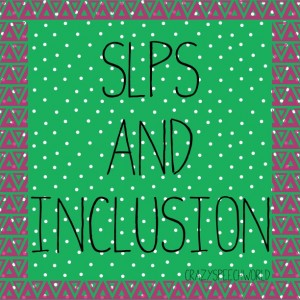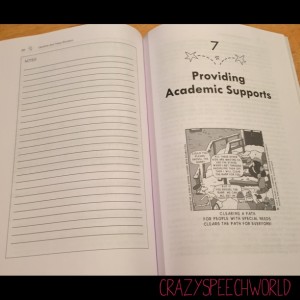This post contains an Amazon Affiliate link Inclusion is one of those topics that either excites or frightens the involved parties. I have been exposed to inclusion since I was in grad school and I loved the idea of it! My involvement in inclusion services varies from year to year, depending on the students and teachers I am working with. I usually stick to providing language services in this way…I still think that I get the best results for articulation when I pull out.
Inclusion is one of those topics that either excites or frightens the involved parties. I have been exposed to inclusion since I was in grad school and I loved the idea of it! My involvement in inclusion services varies from year to year, depending on the students and teachers I am working with. I usually stick to providing language services in this way…I still think that I get the best results for articulation when I pull out.
 I recently got the chance to review this book: The Speech-Language Pathologist’s Handbook for Inclusive School Practices by Juilie Causton and Chelsea P. Tracy-Bronson. It is such a great resource for SLPs, especially if inclusion makes you nervous, but also for other educators because it covers an SLPs role thoroughly.
I recently got the chance to review this book: The Speech-Language Pathologist’s Handbook for Inclusive School Practices by Juilie Causton and Chelsea P. Tracy-Bronson. It is such a great resource for SLPs, especially if inclusion makes you nervous, but also for other educators because it covers an SLPs role thoroughly.
 It includes chapters to help you with collaboration, and providing social, academic, and behavior support in the classroom, which are very easy reading. I love that it includes examples, practical suggestions and ideas, and even some useful forms! I would definitely recommend it as a starting place for SLPs who are interested in providing inclusive services in their own school.
It includes chapters to help you with collaboration, and providing social, academic, and behavior support in the classroom, which are very easy reading. I love that it includes examples, practical suggestions and ideas, and even some useful forms! I would definitely recommend it as a starting place for SLPs who are interested in providing inclusive services in their own school.
 I get lots of questions of how exactly I do this with my own students. So far this year, I am pushing into Kindergarten, 2nd, and 3rd grade classrooms. It really varies what I do in each one! With my kindergartners, I am helping them with group activities and working on building language skills during seat work. It is so easy to do this with the littles in a very natural way! With 2nd grade, I push in during writing time, which is my very favorite! We are able to target so many language goals in that way. During my 3rd grade time, it’s usually science or math. Very easy to target vocabulary skills and comprehension goals with these subjects. Sometimes I pull my own group, other times I float around.
I get lots of questions of how exactly I do this with my own students. So far this year, I am pushing into Kindergarten, 2nd, and 3rd grade classrooms. It really varies what I do in each one! With my kindergartners, I am helping them with group activities and working on building language skills during seat work. It is so easy to do this with the littles in a very natural way! With 2nd grade, I push in during writing time, which is my very favorite! We are able to target so many language goals in that way. During my 3rd grade time, it’s usually science or math. Very easy to target vocabulary skills and comprehension goals with these subjects. Sometimes I pull my own group, other times I float around.
I honestly believe that inclusion is a win/win for everyone involved, if all of the stakeholders are on the same page. It’s a fine line between collaborating and just becoming a helper. Don’t let that happen! You have to communicate with your inclusion teachers to make sure you are all on the same page about your role and goals for when you are in the classroom. I also have my teachers email me their lesson plans each week (which helps ALL of my kids) so I know what is going on and what standards we are targeting, so I can help my students access those. Which is why we are all there anyway, right?
Have you read this book? If not, you can find HERE on Amazon!
What are your thoughts on inclusion?
xoxo,




![Using open ended activities and games in speech therapy can make planning sessions so much easier! Here are a few suggestions that worked well for me. Do you remember the first time you were faced with a mixed group and were realllllllllly unsure about what to do? I do… picture it, St. Augustine 2007 😅 I was […]](https://i.pinimg.com/236x/db/72/cf/db72cf1f6f5da00cb2a13a90872871ea.jpg)
![Using open ended activities and games in speech therapy can make planning sessions so much easier! Here are a few suggestions that worked well for me. Do you remember the first time you were faced with a mixed group and were realllllllllly unsure about what to do? I do… picture it, St. Augustine 2007 😅 I was […]](https://i.pinimg.com/236x/ae/c5/56/aec55688010e2d3489baf744dde59582.jpg)
![Using open ended activities and games in speech therapy can make planning sessions so much easier! Here are a few suggestions that worked well for me. Do you remember the first time you were faced with a mixed group and were realllllllllly unsure about what to do? I do… picture it, St. Augustine 2007 😅 I was […]](https://i.pinimg.com/236x/18/b9/e8/18b9e80227dfe1789e20a21629254f79.jpg)
![Using open ended activities and games in speech therapy can make planning sessions so much easier! Here are a few suggestions that worked well for me. Do you remember the first time you were faced with a mixed group and were realllllllllly unsure about what to do? I do… picture it, St. Augustine 2007 😅 I was […]](https://i.pinimg.com/236x/4d/34/85/4d3485a753178d000223a89b09162317.jpg)
![Using open ended activities and games in speech therapy can make planning sessions so much easier! Here are a few suggestions that worked well for me. Do you remember the first time you were faced with a mixed group and were realllllllllly unsure about what to do? I do… picture it, St. Augustine 2007 😅 I was […]](https://i.pinimg.com/236x/da/7b/c1/da7bc16b9530451d989a578236bc2bff.jpg)
![Using open ended activities and games in speech therapy can make planning sessions so much easier! Here are a few suggestions that worked well for me. Do you remember the first time you were faced with a mixed group and were realllllllllly unsure about what to do? I do… picture it, St. Augustine 2007 😅 I was […]](https://i.pinimg.com/236x/e0/21/a4/e021a465474b16201d23d0a77857935b.jpg)
![Using open ended activities and games in speech therapy can make planning sessions so much easier! Here are a few suggestions that worked well for me. Do you remember the first time you were faced with a mixed group and were realllllllllly unsure about what to do? I do… picture it, St. Augustine 2007 😅 I was […]](https://i.pinimg.com/236x/fa/94/be/fa94be15b6f184b64e2e408bc762a7e8.jpg)

How do we get passed the thoughts of inadequacy in the classroom? Every time I’ve gone in, I feel like I’m in the way, or that I’m not targeting the IEP goals.
Good to see you posting! 🙂
I feel the same way, I’m not sure what to do or how to help or how it’s different from the SPED teacher.
That book looks great! I’ll have to check it out! I am still working on a mostly pull out basis with some push in here and there, depending on the students and teachers. For me, I struggle more with how to define my role from that of the special education teacher. Great post Jenn!
I am currently working in a K-2 building as a part of the RTI team while applying to graduate school. I provide language inclusion for every classroom once a week through various games. I am able to target language goals and work on behavioral issues. Students develop vocabulary, grammar, and pragmatics skills. My kids use complete sentences during every game (we play the same game 2-3 times before learning a new game). The teachers and students love it! I think inclusion is a great way to collaborate with teachers and benefit students! Looking foward to reading yor book suggestion! Thanks:)
Could you give a few examples of the kinds of games you play when you do inclusion?
Thanks for the book review! Definitely one I need to read. For those you do push in, are you also pulling out once weekly or in some combo? Being at a new school, doing only push in with some groups has been tough as I don’t know the kids yet. I’m leaning toward a combination approach!
I do both with most grades, except kindergarten. It really is up to you and what you feel is best for your students!
Would you be able to provide an example of an inclusion lesson you’ve done successfully? Also, when you have several of your students in a classroom and they all have different goals, how do you make sure you target each goal, while giving ample opportunities to practice them (e.g., 10 attempts)? Thank you!
The most successful inclusion set ups for me are usually when I am one of their centers in the student’s rotation during literacy centers. That way I can work on their goals in a group, just like I would in my room. I don’t have more than 2-3 students in a classroom I am working with.
Love the writing time. That would seem like a naturally valuable time.
Looks like a great read! I find it so much easier to push in to K-4. Once we hit 5-8 I’ve found the teachers are so pressed to accomplish their plans that I feel like a third wheel. I’ve been trying to approach push-in via an academic conversations approach and feel that will have a greater application in the upper grades.